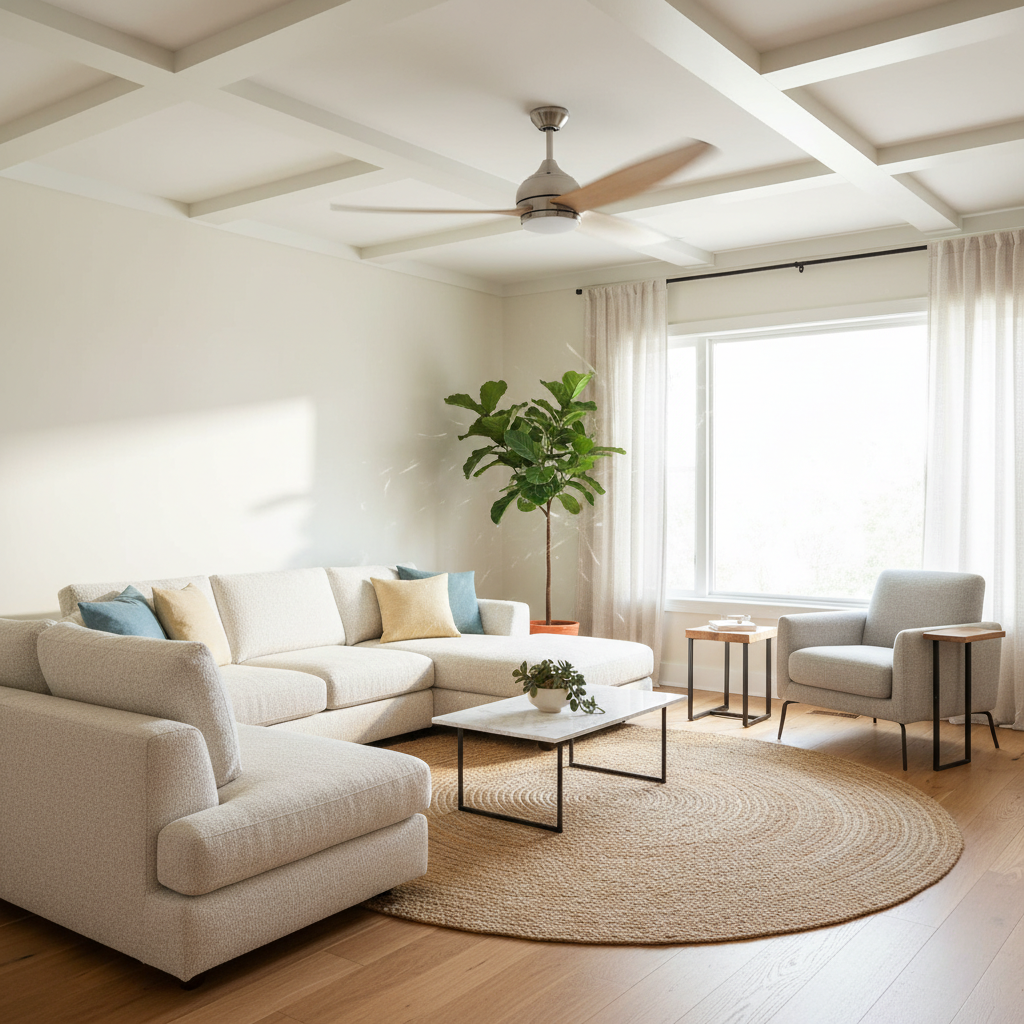Ah, summer! The season of sunshine, outdoor fun, and… relentless heat. While air conditioning is a lifesaver, it can also be a wallet-drainer. That’s where our trusty ceiling fans come into play. But here’s a little secret many people miss: just having a ceiling fan isn’t enough. Its *placement* is absolutely critical to whether it’s actually making you feel cooler or just stirring the hot air around like a confused bird.
Trust me, I’ve been there. I used to just plonk fans wherever they fit, thinking “a fan is a fan, right?” Wrong! After sweating through a few summers and noticing some rooms felt way hotter than others, even with a fan on full blast, I started digging. What I discovered completely changed how I think about keeping cool and, honestly, saved me a bunch on my energy bills. If you want to unlock your ceiling fan’s full potential this summer, saving energy and staying genuinely comfortable, you’ve come to the right place. Let’s dive in!
Why Placement Matters More Than You Think
You might think a fan just blows air around, and that’s it. Simple, right? Well, not quite. A ceiling fan doesn’t actually lower the room’s temperature like an air conditioner does. Instead, it creates a “wind-chill effect” on your skin. When the air moves across your skin, it helps evaporate sweat, making you *feel* cooler. It’s the same principle as a gentle breeze on a warm day.
But for this magical wind-chill effect to work its best, the air needs to be directed effectively. If your fan is too high, too small, too close to a wall, or spiing the wrong way, that precious breeze gets lost, dispersed, or just creates dead zones. You’ll end up feeling stifled and wondering why you even bothered turning the fan on. Correct placement ensures that the air is moved efficiently, reaching the areas where you spend your time, thus maximizing that lovely cooling sensation.
The Basics: Room Size and Fan Size – A Dynamic Duo
Before we even talk about where to hang it, let’s make sure you’ve got the right tool for the job. A tiny fan in a cavernous living room is about as effective as a spoon trying to empty a swimming pool. Conversely, an oversized fan in a small bedroom can feel like a wind tuel.
Here’s a quick guide to matching fan size (measured by blade span) to room size:
- Small Rooms (up to 75 sq ft): Think small bathrooms, walk-in closets, or compact kitchens. A fan with a 29-36 inch blade span usually does the trick.
- Medium Rooms (76-144 sq ft): Perfect for average bedrooms, home offices, or small dining areas. Look for a 36-44 inch blade span.
- Large Rooms (144-225 sq ft): Most standard living rooms, master bedrooms, or larger dining rooms fall into this category. A 44-54 inch blade span is generally ideal.
- Extra Large Rooms (225-400 sq ft and up): Open-concept living spaces, very large family rooms, or great rooms might need a fan with a 54-60 inch span. Sometimes, multiple fans are the best solution here, which we’ll discuss next.
I learned this the hard way years ago. I put a small, cute fan in my rather large living room, and it was practically useless. It looked nice, but the cooling power was non-existent. Upgrading to a fan with a wider blade span made a world of difference!
The Sweet Spot: Ceiling Height and Downrod Length
Once you have the right size fan, the next crucial factor is its height from the floor. For optimal airflow and safety, ceiling fan blades should ideally be between 7 and 9 feet from the floor.
- Too High: If your fan is too close to the ceiling (especially high ceilings), the air has too much distance to travel before it reaches you, losing its effectiveness and dispersing too much. You’ll barely feel a whisper of a breeze.
- Too Low: On the flip side, a fan that’s too low can be a safety hazard, especially in rooms with taller occupants or active kids. Plus, it can make the room feel cramped and interfere with light fixtures or doors.
For standard 8-foot ceilings, a “flush mount” or “hugger” fan (one that mounts directly to the ceiling) or a fan with a very short downrod is usually perfect. However, if you have higher ceilings (9 feet or more), you’ll need a downrod. A downrod is simply a pole that extends the fan further down from the ceiling. The general rule is to use a downrod long enough to bring the blades into that 7-9 foot sweet spot. Manufacturers usually provide guidelines for downrod lengths based on ceiling height, so always check those recommendations.
The Golden Rule: Center of the Room (Mostly!)
For most square or rectangular rooms, the most efficient and effective placement for a ceiling fan is dead center. Why? Because from the center, the fan can distribute air most evenly throughout the entire space. It allows the air to spread out radially, reaching all corners and creating a consistent cooling effect across the room. This is the go-to advice from almost every expert in home comfort, and for good reason – it simply works best for standard layouts.
Beyond the Center: Tackling Tricky Room Layouts
Life isn’t always a perfect square, is it? Some homes have unique layouts that require a bit more thought than just “center of the room.” Don’t fret; we’ve got solutions for those too!
Long, Narrow Rooms
Imagine a long living room or a combined living/dining area. A single fan in the middle might cool one half beautifully while leaving the other half feeling neglected. In these cases, you have a couple of options:
- Multiple Fans: The most effective solution is often to install two (or even more, depending on length) smaller fans, evenly spaced along the length of the room. This ensures consistent airflow throughout.
- Strategic Single Fan: If multiple fans aren’t an option, place a single larger fan in the area where you spend the most time – perhaps over the main seating arrangement in a living room, or over the dining table if that’s your primary use of the space. It won’t cool the *entire* room equally, but it will prioritize your comfort.
I remember visiting a friend’s house with a really long family room. They had one fan at one end, and it was like entering a different climate zone at the other! Clearly, two fans would have made a huge difference.
L-Shaped Rooms
L-shaped rooms are essentially two distinct areas coected. Trying to cool both with one fan is usually an exercise in frustration. Your best bet here is to treat it as two separate zones and install a fan in each “arm” of the L. If that’s not feasible, identify the main activity zone and place a fan there, perhaps a larger one if it can cover a decent portion of both sections from a central point.
Open-Concept Spaces
Open-concept living is fantastic for socializing, but it can be a nightmare for cooling. Since these areas are essentially one giant space, you’ll almost certainly need multiple fans. Think about how you use the different zones (living, dining, kitchen) and place fans strategically over each primary zone. For example, one over the living area, and another over the dining table. The key is to ensure overlapping coverage to keep the air moving across the entire space effectively. It’s about creating a series of comfortable microclimates.
Direction Matters: Summer vs. Winter Mode
This is a big one that many people overlook! Ceiling fans have a directional switch, usually a small slider on the motor housing. It changes the direction of the blade rotation, and this is crucial for seasonal efficiency:
- Summer Mode (Counter-clockwise): For summer, your fan should spin counter-clockwise (when looking up at it) to push air *downward*. This creates that lovely direct breeze that makes you feel cooler due to the wind-chill effect.
- Winter Mode (Clockwise): In winter, you want the fan to spin clockwise at a low speed to gently pull cool air up, pushing warm air (which rises) down and around the room. This helps redistribute heat without creating a draft.
Always double-check your fan’s direction as the seasons change. It’s a simple flick of a switch that makes a world of difference!
Don’t Forget About Obstructions!
Even the perfectly sized, perfectly placed fan can be ineffective if it’s too close to obstructions. Here are a couple of key clearance rules:
- Walls: Ensure your fan blades are at least 18-24 inches (about 45-60 cm) away from the nearest wall. If the blades are too close, they’ll just chop the air against the wall, reducing efficiency and sometimes even creating an aoying hum or wobble.
- Furniture & Light Fixtures: Make sure the fan blades have a clear, unobstructed path. Don’t place them directly above tall cabinets, wardrobes, or where they might interfere with other hanging light fixtures or even open doors. Safety and efficiency both suffer.
I once had a fan too close to a window with curtains, and the curtains would flap wildly, disturbing the airflow and making a rather aoying noise. It taught me the importance of giving the fan its own clear space.
Optimizing Your Fan Usage: Beyond Placement
Once your fans are perfectly placed, here are a few extra tips to get the most out of them:
- Work with AC, Not Against It: Ceiling fans and air conditioning are a power duo. You can often raise your AC thermostat by 2-4 degrees Fahrenheit when a fan is ruing because the fan makes you *feel* cooler. This means significant energy savings!
- Turn Them Off When You Leave: Remember, fans cool people, not rooms. There’s no point in leaving a fan on in an empty room, as it won’t lower the ambient temperature. Turn it off when you exit.
- Keep it Clean: Dust buildup on fan blades can reduce efficiency and even cause the fan to wobble. Give those blades a regular wipe-down for optimal performance.
Conclusion
So there you have it! Who knew there was so much to consider when it comes to ceiling fans? From choosing the right size for your room and finding that ideal height, to the crucial “center of the room” rule (with smart exceptions for tricky layouts), ensuring the correct summer direction, and giving it plenty of clear space – every detail contributes to your comfort and energy savings.
By applying these simple, experience-backed principles, you’re not just installing a fan; you’re engineering a smarter, cooler home environment. Go ahead, take a look at your ceiling fans, make those adjustments, and enjoy a much more comfortable, energy-efficient summer. Stay cool, my friends!




